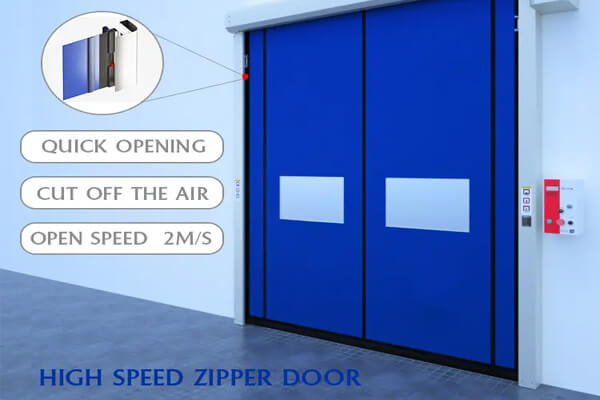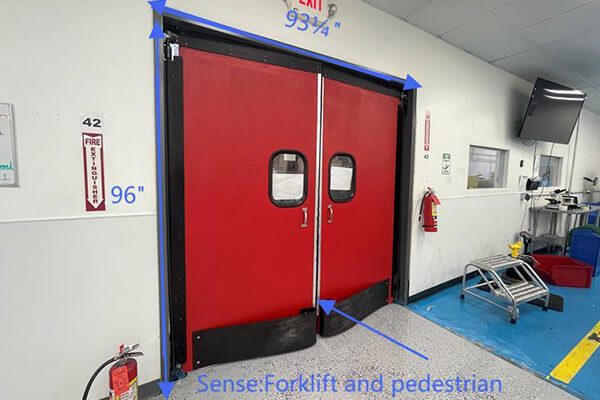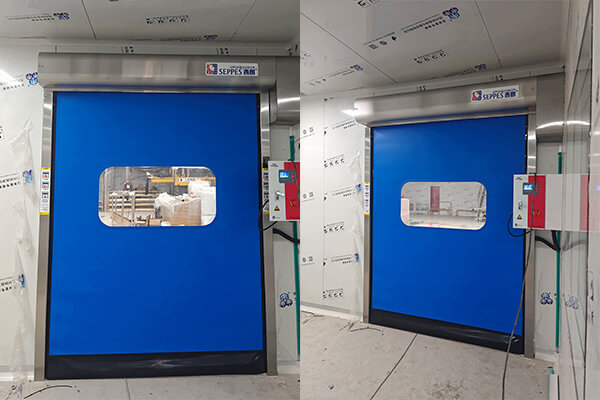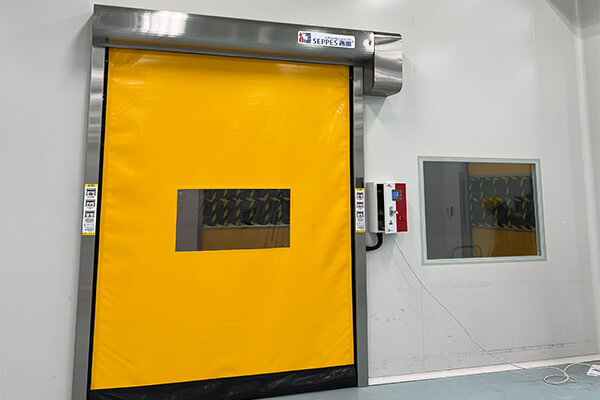In today’s highly regulated pharmaceutical and healthcare industries, the demand for high-performance door solutions is rapidly increasing. Facilities are constantly seeking ways to enhance contamination control, streamline workflow, and ensure strict compliance with GMP standards. Traditional steel swing doors, once the industry standard, are now being replaced by advanced alternatives such as zipper-type fabric roll up doors. These innovative self-repairing rapid doors offer speed, airtightness and automation, making them ideal for pharmaceutical and healthcare applications.
A recent example comes from a leading US-based pharmaceutical and healthcare plant, which upgraded its facility by replacing conventional steel double swing doors with zipper fabric roll up doors. This shift not only improves plant operational efficiency and pollution control, but also sets a new benchmark for industry safety and compliance.
By exploring the benefits and technological advancements of high speed fabric doors. This article will explain why more pharmaceutical and healthcare facilities are making the switch to these high-performance solutions.

Contents
- 1 What Are Fabric Roll Up Doors?
- 2 Why Are Zipper High Speed Fabric Doors Trending in Pharma and Healthcare?
- 3 High Speed Zipper Fabric Doors vs. Steel Double Swing Doors: In-Depth Comparison
- 4 Case Study: US Pharmaceutical Plant Replaces Steel Swing Doors
- 5 How to Select the Right Fabric Roll Up Door for Your Facility
- 6 FAQ
What Are Fabric Roll Up Doors?
Fabric roll up doors are an innovative entrance solution that meets the requirements of pharmaceutical industry environments. These high speed doors with PVC fabric that can be quickly opened and closed by vertical roll-in. Their primary function is to provide fast, reliable, and hygienic separation between controlled spaces within a facility.
Definition and Working Principle
Fast roll up door operates on a motorized system to quickly raise and lower the door curtain and minimize noise. At the heart of its design is the double zipper seal construction of the track. This zipper type allows the fabric curtain to slide securely within the side rails, creating an airtight seal that prevents dust from entering.
When activated, the door’s high-speed motor ensures rapid opening and closing, which not only increases workflow efficiency but also helps maintain strict temperature and pressure differentials essential in pharmaceutical production and healthcare processing zones.
Key Advantages Over Traditional Steel Swing Doors
Unlike steel double swing doors, which open and close slowly on hinges and are prone to gaps and air leakage, fabric roll up doors provide a much faster and more reliable barrier against contamination. Steel swing doors typically require manual operation and are less suited for areas with high traffic or frequent material handling. They may also present cleaning challenges and higher maintenance needs, especially in sterile or regulated environments.
| Performance Metric | Zipper Fabric Roll Up Door | Steel Double Swing Door |
| Air Leakage Rate(Sealing) | < 0.1 CFM/sq.ft. A virtually airtight seal from the zipper track minimizes air infiltration and energy loss. | > 3.0 CFM/sq.ft.Significant gaps around the entire perimeter lead to constant, uncontrolled air exchange. |
| Typical Opening Speed(Efficiency) | 0.8-1.2m/sAllows for rapid transit, keeping traffic flow seamless and reducing wait times to near zero. | 0.2m/sSlow movement creates major bottlenecks and forces personnel and equipment to wait. |
| Door “Open Time” Per Cycle<br/>(Efficiency) | 4-6 secondsThe door is open for the absolute minimum time required, preserving the internal environment. | 15-20 secondsProlonged open time compromises environmental control and slows down the entire operation. |
| Impact Recovery Time(Durability) | **~ 0-10 seconds (Automatic) | 1 – 48+ hours (Manual Repair) |
| Design Lifecycle | 1,000,000+ cycles | 100,000 – 250,000 cycles |
| Sanitation Time (Hygiene) | 5 minutes | 15 minutes |
| Annual Energy Savings Potential | Up to 35% reduction in HVAC costs | Negligible / Net Loss |
| Performance Criteria | High-Speed Fabric Roll Up Door | Steel Double Swing Door |
| Environmental Control | ⭐⭐⭐⭐⭐ | ⭐⭐ |
| Contamination Control | ⭐⭐⭐⭐⭐ | ⭐⭐ |
| Operational Efficiency | ⭐⭐⭐⭐⭐ | ⭐⭐⭐ |
| Space Footprint | ⭐⭐⭐⭐⭐ | ⭐⭐ |
| Safety | ⭐⭐⭐⭐ | ⭐⭐⭐ |
| Maintenance Cost | ⭐⭐⭐⭐ | ⭐⭐ |

Why Are Zipper High Speed Fabric Doors Trending in Pharma and Healthcare?
In recent years, fabric roll up doors have experienced a significant surge in popularity within pharmaceutical and healthcare facilities. Facility managers and engineers are increasingly searching for “fabric roll up doors” to upgrade their plants with the latest technology.
Meeting the Demand for Fast, Reliable, and Clean Solutions
One of the main reasons fast roll up doors are trending is the growing demand for access solutions that are not only fast and reliable but also easy to clean. In pharmaceutical and healthcare plants, doors must accommodate high-frequency use while maintaining strict cleanliness. High speed zipper doors use servo motors to minimize waiting times and help preserve essential air pressure differentials between sterile zones. Their smooth PVC surfaces and innovative zipper construction make them easy to clean and disinfect, perfectly addressing the hygiene needs of sensitive environments.
Compliance with FDA, GMP, and Hygiene Regulations
Strict compliance with FDA, GMP, and other hygiene regulations is essential in pharmaceutical and healthcare settings. Fabric roll up doors are engineered to provide an airtight seal, reducing the risk of airborne contamination and supporting regulatory requirements for controlled environments. Their zipper design and sealing capabilities help facilities meet and exceed industry standards for cleanliness, safety, and cross-contamination prevention, making them a preferred choice for compliance-driven organizations. For more details on cleanroom standards, refer to ISO 14644 Cleanrooms and Associated Controlled Environments.
Preferred Choice for Modern Facilities
As the focus on automation, hygiene, and process reliability intensifies, more pharmaceutical and healthcare facilities are choosing fabric roll up doors over traditional options. These doors not only boost productivity and operational safety but also consistently appear at the top of search results for facility upgrades. Their combination of speed, airtightness, and ease of cleaning positions fabric roll up doors as the leading solution for modern pharmaceutical and healthcare plants.

High Speed Zipper Fabric Doors vs. Steel Double Swing Doors: In-Depth Comparison
Cleanliness and Hygiene Advantages
When it comes to maintaining the highest standards of cleanliness and hygiene, fabric roll up doors offer significant advantages over traditional steel swing doors. The smooth PVC surface of rapid roller doors is easy to clean and disinfect, which helps prevent the buildup of dust, bacteria, and other contaminants. The zipper design ensures a tight seal, reducing the risk of cross-contamination between different areas. In contrast, double swing doors often have gaps and exposed hinges that can harbor dirt and are more challenging to sanitize.
Speed and Workflow Efficiency
Fabric roll up doors are engineered for high-speed operation, often opening several times faster than conventional double swing doors. This rapid opening reduces waiting times for staff and equipment, streamlines workflow in busy production lines. For facilities where time and efficiency are critical, fabric roll up doors help optimize traffic flow and support productivity, while steel swing doors can slow operations due to their manual, slower action.
Airtightness and Environmental Control
Airtightness is essential in pharmaceutical and healthcare settings to maintain strict environmental controls and prevent contamination. Fabric roll up doors with zipper construction provide good seal that limits the escape of air, dust, and contaminants. This feature helps maintain stable temperature, humidity, and air pressure in controlled environments. Steel swing doors, on the other hand, often allow for air leaks and are less effective in maintaining the required conditions for clean rooms.
Maintenance, Durability, and Life cycle Costs
Fabric roll up doors are designed for durability and low maintenance. Their self-repairing mechanism allows the door curtain to reinsert itself into the tracks if dislodged, minimizing downtime and repair costs. The materials used are resistant to chemicals and frequent cleaning, extending the door’s lifespan. Steel swing doors, while robust, are prone to hinge and latch wear, require more frequent maintenance, and may need costly replacements over time. As a result, fabric roll up doors typically provide lower life cycle costs and higher long-term value.
Safety Features
Modern rapid roll doors are equipped with advanced safety features such as soft bottom edges and integrated sensors. These technologies reduce the risk of injury by stopping or reversing the door if an obstruction is detected, providing a safer environment for staff and equipment. Steel swing doors lack these automated safety enhancements and can pose a higher risk of accidents, particularly in high-traffic areas.
Key Benefits for Pharmaceutical & Healthcare Facilities
For pharmaceutical and healthcare facilities, the choice between self-repair high speed doors and steel swing doors is clear. Fast roll up doors offer cleanliness, faster operation, better environmental control, lower maintenance and safety. These advantages make them the ideal solution for facilities that demand strict hygiene, regulatory compliance, and operational efficiency, helping organizations create safer, more productive, and compliant work spaces.
| Feature / Criteria | High-Speed Fabric Roll Up Door | Traditional Steel Double Swing Door |
| Sealing Structure | Excellent Seal: Creates a tight, full-perimeter seal (top, bottom, and sides). Effectively maintains pressure differentials and minimizes air leakage. Ideal for climate and contamination control. | Poor Seal: Inherent gaps exist at the floor, between the doors, and around the frame. Ineffective at maintaining pressure or preventing air infiltration. Prone to energy loss. |
| Operational Efficiency | High Efficiency: Extremely fast opening and closing speeds (up to 100″/sec). Automated activation (sensors, loops) allows for a smooth, continuous traffic flow. Dramatically reduces cycle times. | Low Efficiency: Slow, manual, or semi-automated operation. Obstructs workflow and creates bottlenecks for personnel and forklifts. Significantly increases cycle times. |
| Safety | High Safety Level: Flexible, lightweight curtain absorbs impact, reducing risk of injury or damage. Equipped with safety sensors (photo-eyes, light curtains) to prevent closure on obstructions. Breakaway and self-repairing features are often standard. | Moderate Safety Risk: Heavy, rigid panels pose a significant collision hazard. Can cause serious injury to personnel or damage to equipment. Creates a large swing hazard zone and potential pinch points. |
| Improved Hygiene | Superior Hygiene: Smooth, non-porous PVC or fabric surface is easy to clean and sanitize. Minimal seams or hardware where contaminants can harbor. Designed to meet strict GMP and FDA standards. | Hygiene Challenges: Seams, handles, hinges, and edges create areas for microbial growth. Difficult to clean thoroughly, posing a cross-contamination risk. Not ideal for sterile or cleanroom environments. |
| Maintenance & Durability | Low Maintenance & High Durability | High Maintenance & Vulnerable: |
| Overall Verdict | The modern, high-performance solution for controlled environments. | An outdated, inefficient option for demanding industrial or clean-critical applications. |
Case Study: US Pharmaceutical Plant Replaces Steel Swing Doors
A leading US-based pharmaceutical and healthcare manufacturing facility specializes in producing sterile medications and high-value medical products. With requirements for GMP, the plant operates several cleanrooms and high-traffic corridors where environmental control and hygiene are critical.
Reasons for Replacing Steel Swing Doors
The facility’s original layout featured traditional steel swing doors in multiple cleanroom zones and main passageways. Over time, it became clear that there were a number of problems.
- Double swing doors were slow to operate, difficult to keep fully sealed. And prone to collecting dust and contaminants around hinges and edges.
- Manual operation can result in a slower workflow.
Selection Process for Fabric Roll Up Doors
The site engineering team evaluated existing industrial door technologies, focusing on products that offered speed, hygiene and airtightness. After consulting with SEPPES industrial door manufacturers and referencing success stories, the team ultimately chose a roll-up door with zipper construction. The solution is also compatible with access control and cleanroom automation systems.

How to Select the Right Fabric Roll Up Door for Your Facility
Assessing Facility Needs and Door Specifications
Selecting the right high speed roll up door begins with a thorough assessment of your facility’s operational requirements. Consider the specific environments where the doors will be installed — such as cleanrooms, production areas, or loading docks — and evaluate factors like frequency of use, traffic volume, and the level of contamination control required. Documenting these needs ensures that you choose a door system tailored to your workflow, space constraints, and compliance obligations.
Key Selection Factors: Material, Speed, Automation, and Safety
When comparing fabric roll up door options, it’s essential to focus on several core parameters. The material of the door curtain should be robust, easy to clean, and resistant to chemicals commonly used in pharmaceutical facilities — PVC is often preferred for its hygienic properties. High opening and closing speeds reduce waiting times and support efficient workflows, while advanced automation features, such as integration with access control or touchless operation, are vital for enhancing safety and productivity. Always check for certifications that demonstrate compliance with FDA, GMP, or other relevant standards, and ensure the door offers built-in safety features like soft bottom edges and responsive sensors.
Common Questions About Fabric Roll Up Doors in Healthcare Industry
Facility managers often have key questions when considering fabric roll up doors for pharmaceutical applications. Common concerns include the durability and lifespan of the doors, ease of cleaning and maintenance, integration with facility automation systems, and the ability to meet strict regulatory requirements. Addressing these questions with your supplier — and seeking out doors with tested performance in pharmaceutical environments — will help you make an informed, confident decision that supports both compliance and operational excellence.
FAQ
Q: Can fabric roll up doors directly replace steel doors?
A: Yes, professional manufacturers can seamlessly remodel according to the site size and structure.
Q: Are PVC roll up doors durable?
A: The service life of high quality fabric roll up doors can reach hundreds of thousands of openings and closings with convenient maintenance.
Q: Will it affect the temperature and humidity of the workshop?
A: No, it helps to control environmental parameters better.
Fabric roll up doors offer multiple advantages such as high sealing, fast opening, safety protection and energy saving. They significantly improve the quality of the production environment, the efficiency of operations and the competitiveness of your organization. If you are considering upgrading the rapid door system in your factory, you are welcome to consult a professional supplier such as SEPPES for a customized solution to upgrade your production environment.




